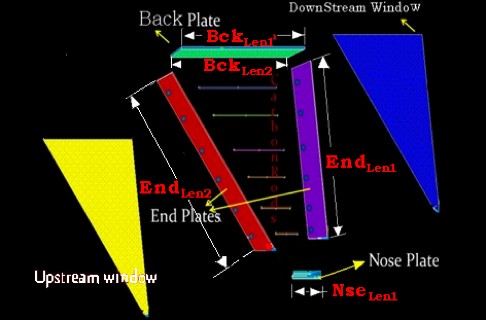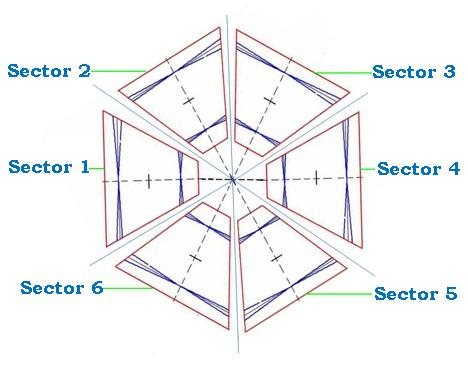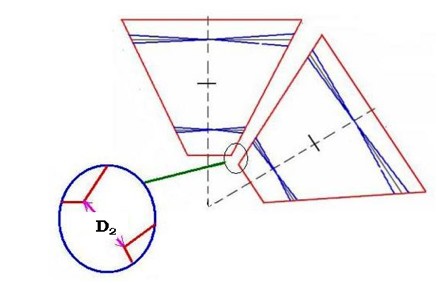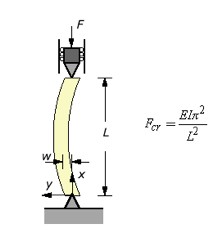R3DC Report 2-08
Introduction
In this document we discuss the design of the Region 3 Drift Chambers (R3 DC) for the Hall-B 12-GeV upgrade (CLAS12). The objective for CLAS12 detectors is to achieve nearly full acceptance in the lab frame for the relativistic forward-boosted final-state particles while maintaining a medium momentum resolution of 0.5 to 1% for a 5-GeV charged particle.
The six identical R3 DCs will be located 4.7 meters from the target and together the chambers will possess nearly full 2-π azimuthal coverage and will span from 5 to 45 degrees in polar angle as measured from the direction of the electron beam. The central plane through the R3 DC will make an angle of 25 degrees with respect to a perpendicular to the beam. The toroidal coils will occlude {how many degrees?} in azimuth. The shadow of the toroidal coils will result in a minimum gap of 16 cm between each R3 DC which hinders reconstructing the trajectory of scattered particles. This will provide the space for the readout boards, attendant electronics, cabling, etc. The active area for each R3 DC will then be [60 - ?] in azimuth,
The design of the R3 DC for CLAS12 is based on the successful hexagonal cell structure of the current CLAS R3 DC. Below we delineate the design criteria:
- Smaller cell size of 2.07 cm to accommodate a luminosity of 1035 cm-2 s-1 and maintain an accidental occupancy of less the 4% for high tracking efficiency..
- Sense wires will be increased to 30 um from the current 20 um diameter. This means that the wire will require a higher tension to offset droop and electrostatic forces.
- All wires in each superlayer will lie in a plane instead of on a cylindrical surface. The staggered by one half cell or “brick wall pattern” of the hexagonal cells will be maintained for each successive layer.
- To enhance the azimuthal (φ) resolution, each superlayer will be +/- stereo, i.e. the pitch will be +6 degrees in the six layers of the first superlayer and the pitch will be -6 degrees for the second superlayer array of six wire planes. The current R3 DC has 0 and 6 degree pitch respectively for the two superlayers.
- There will be a total of 4928 wires of which 1344 (check this) will be sense wires.
- Endplates will be secured into rigid frames. The endplates will be oriented 60○ with respect to one another. Into each endplate will be precisely drilled holes with tolerance of better than 100 um. Into these hole will be placed the feedthrough assemblies for precisely positioning the sense, field, and guard wires. The expected overall position accuracy will be 250 um per layer, with a wire location accuracy of 200 um.
- The deflection along the length of the endplates may not exceed 50 um.
- The R3 DCs will be supported from only two points at the outer backplane. This makes the R3 DCs self supporting.
- The nose plate for each R3 DC will be positioned onto a precision support hexagonal ring for aligning all R3 DCs with respect to the surveyed Hall B coordinate system.
The mechanical engineering aspects of the R3 DC is discussed below in light of the above design criteria. We present a two dimensional Finite Element Analysis. The three-dimensional FEA is currently under study
R3 Description
Geometry
An exploded view of a single R3 sector is shown below. The back plate, nose plate, and two endplates represent the key components to the main ionization chamber structure. The back plate is approximately 5 meters long and will likely have two mount points to support and position the drift chambers. The nose plate, more than half a meter long, will hold a ball joint that mounts to a hexagonal ring and constrains the chamber location at a third point. The drift chamber wires are held in place by the end plates which have carbon fiber rods spanning the gap in order to reduce end plate deflection arising from the wire tension, the weight of the chamber, and the gas volume inside the chamber. The front and back faces of the chamber have thin windows to allow the passage of scattered particles with limited multiple scattering. Six of these chambers are oriented around a beam pipe as shown in the figure below.
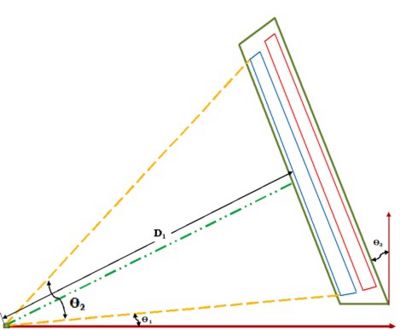 |
| ||||||||||
| A side view of a R3 drift chamber. The distance from the target center to the first sense wire is labeled . The min an max acceptance angles are labeled and repsectively. The tilt angle with respect to a normal to the beam line is labeled . |
Material Specifications
Physical properties germane to the materials used to construct the R3 dirft chambers are shown in the table below. End plates for R3 drift chambers in the previous 6 GeV CLAS detector were fabricated by gluing thin (0.048 inch) stainless steel sheets onto a Polyeurethane foam. The current design expects to use the same structure for the end plates. The use of carbon fiber rods to minimize end plate deflections is another design feature borrowed from the previous 6 GeV CLAS detector design. Aluminum is included below as cadidate material for the face and end plates.
| Material | Youngs Modulus | Density |
| Polyeurethane Foam FR-3700 | 240 | |
| Stainless Steel | 8030 | |
| Carbon Fiber Rods | 580 | |
| Aluminum | 2700 |
Specific part Drawings
Preliminary drawings of the end plate and nose plate are shown below. The end plate and nose plate are two critical parts of the chamber. The end plate will constrain the detector wires in space while the nose plate will determine the tilt angle of the detector.
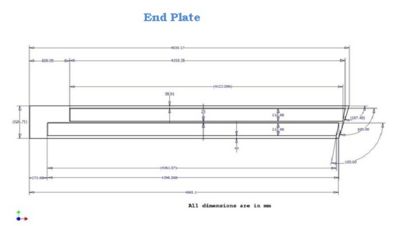
|
| A preliminary End plate design for R3 Drift Chamber. |
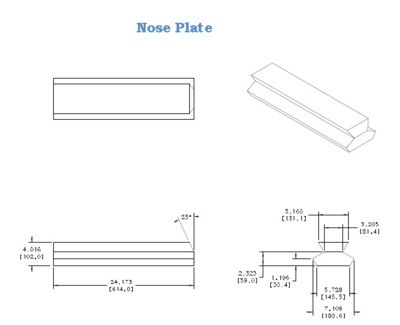
|
| A preliminary Nose plate design for R3 Drift Chamber. |
Endplate Deflection
Wire tension
As shown in the figure below, The drift chamber wires are oriented at 6 degrees with respect to the horizontal. Wires which slope upward from left to right make an angle with repect to the perpendicular to the endplate of degrees. If T represents the tension in the wire, then the component of this force perpendicular to the endplate is . Wires which slope downward from left to right make an angle of degrees with respect to a perpendicular to the endplate and have a force component along the perpendicular of . The net force perpendicular to the endplate will be . There are 112 sense wires in each of the 12 wire layers ( 2 super layers with 6 wire layers each)[Mestayer07]. The remaining field and guard wires total . The sense wires are tensioned using at least a 30 g mass. The field and guard wires are tensioned using at most a 150 g mass. The total tension from all wires on the endplate will be . This tension is cut in half after the wires are crimped to the adjacent endplate.
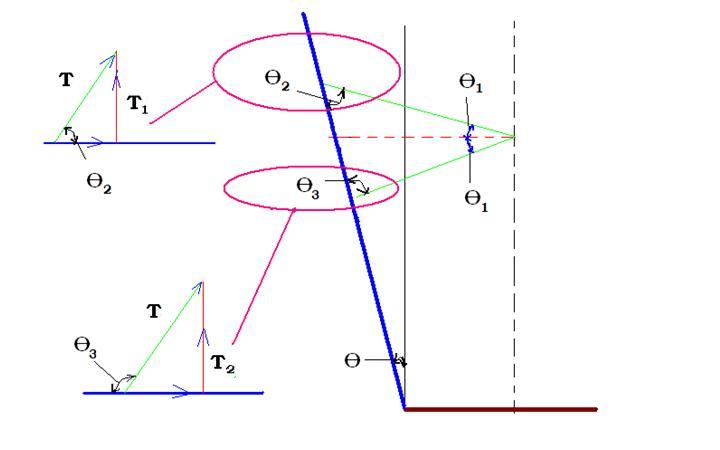
|
| ||||||||||
| The above figure identifies the direction of the sense wire tension in terms of the and . |
Point Load Deflection
The force on an endplate due only to the tension from the 4,928 wires is about 5700 N /2. A simple calculation based on the definition of Young's modulus can yield an order of magnitude level estimate for the deflection of an Aluminum endplate in which the wire exerts a force perpendicular to the endplate. The deflection of the endplate in terms of Young's Modulus is given by the equation:
where
- Young's Modulus for Aluminum
- point force/load
- width of the endplate
- deflection of endplate due to point force
- length of the endplate
- thickness of the endplate
A deflection of 7 mm is expected for a 5 cm thick Aluminum endplate, after solving the above equation for and inserting the given values. If a 5 cm thick stainless steel endplate were used, the deflection would drop by almost factor of 3 from 7 mm to 2.5 mm due to the linear dependence of the deflection on Young's Modulus. The previous work of Kevin Folkman came to a similar conclusion.
Distributed Load Deflection
The endplate deflection calculation was redone assuming a more realistic case in which the load is distributed evenly along the endplate. The tension of the wires on the endplate was divided into three regions; W1,W2, and W3. As shown in the Figure below, the load W3 corresponds to a region along the endplate in which wires from both super layers are creating a load on the endplate. Loads W1 and W2 represent regions in which only 1 super layer is causing a load. The endplate is "simply" supported in order to calculate the deflection. The "simple" support has a point support on the left side in which the endplate may rotate but not translate (move left or right). The right hand side of the plate is supported such that the endplate can both rotate and translate. The figure below labels the loads as well as distances over which the loads are applied on the end plate. A total force of 340 lbs exerted by the drift chamber wires is decomposed into its components according to the angle made by the wire on the endplate.
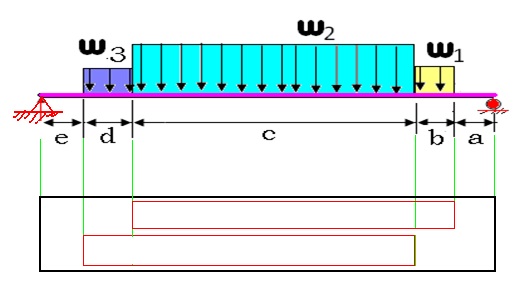
|
| A diagram of the loads on the End Plate. |
| Label | value |
| a | 99.02 mm |
| b | 96.22 mm |
| c | 4025.88 mm |
| d | 335.17 mm |
| e | 273.88 mm |
| 0.255 N/mm | |
| 0.59 N/mm | |
| 0.335 N/mm |
Assumptions
The following assumption were made in the hand calculation:
- The end plate is made of homogenous uniform elastic material with a Young's Modulus of E=210 x 103 N/mm2 (Stainless Steel).
- The horizontal component of the loading is completely neglected.
- The deflection in the x-direction is negligible.
- The end plate is rectangular in shape with a width of 526 mm and thickness of 50.8 mm resulting moment of inertia (I) =5746.4 .
- The loading provided by wire tensions are equivalent to a uniformly distributed load.
- The maximum deflection occurs along the length which is represented by in the diagram.
- The loading applied is under the elastic limit of the material.
- The effects of the endplate weight are ignored.
The moments experience along the endplate are shown below for each of the 5 distances.
where represents the .
The deflection in the y-direction is governed by the equation
where represents Young's Modulus and is the Area Momentum of Inertia. The Area Moment of Inertis (I_A) is defined as the second moment of an area about a given axis.
- Area moment of inertia about the x-axis.
The mass moment of Inertia is defined as
If we assume that the largest amount of deflection occurs in region c, then we may integrate the above 2nd order differential equation once and determine the critical point which represents the point of maximum deflection ( contra flexure).
- =
- constant of integration
Apply the boundary conditions that the slope is zero to determine the constant of integration.
Setting to zero and solving for x give the result that x = 1654.96 mm. In other words, the maximum deflection occurs 1654.96 mm from region of the endplate or 1 mm from the right hand side of the endplate.
Integrating the equation a 2nd time will result in an equation for the amount of the deflection. Substituting the value of x above results in a predicted deflection in the Y deflection of 2.2 mm after dividing by . The predicted deflection is only slightly smaller than a point load when the load is distributed along the length of the end plate.
Distributed load FEA
A Finite Element Analysis (FEA) was performed using the computer software ANSYS. The maximum deflection observed was 2.144 mm as shown in the Figure below and differs from the hand calculation by only 3%. In addition to validating the FEA analysis with hand calculations, the above results also reveal the challenge of reducing the endplate deflection using stiffer materials due to an essentially linear dependence of the deflection to Young's Modulus. The cubic dependence of the deflection on the thickness of the endplate, however, can be used to reach the minimum endplate deflection criteria of 50 instead of using stiffer material. Increasing the endplate thickness comes at the cost of increasing the end plate mass. As a result, composite materials were considered in order to minimize weight. The performance of these composite materials is shown in the 3-D model section of this report.
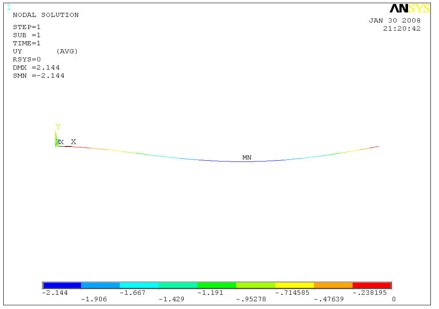
|
| An FEA analysis of the End Plate deflections. |
Composite End Plate
Effective Young's Modulus Y_{eff}
The R3 end plate used in the CLAS 6 GeV detector was a Polyeurethane core 2 inches thick with 0.048 inch thick stainless steel plates on each side as shown below.
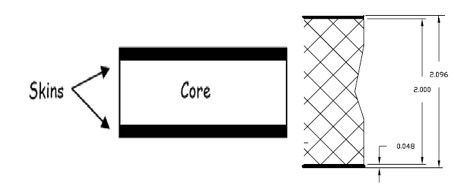
|
| The Polyeurethane-Stainless Steel endplate dimensions. |
The effective Young's modulus for this endplate weighted by the volume of each plate is
where
- inches
- inches
FEA Deflection results
The effective Young's Modulus of was used to determine the deflection of an endplate with and without the presence of the carbon fiber support rods.
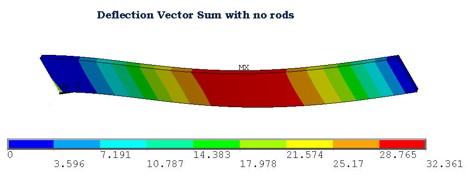 |
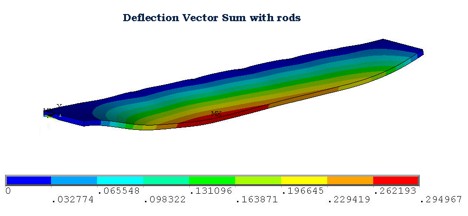
|
| FEA predicted deflections for the Polyeurethane-Stainless Steel composite end plate. |
| Configuration | X max | Y max | Z max | D max |
| (mm) | (mm) | (mm) | (mm) | |
| No rods | .669163 | 32.361 | .040403 | 32.361 |
| With rods | .010285 | 0.294589 | 0.15953 | .294967 |
Only the dark and light blue regions near the carbon fiber rods appear to have deflections below the specification. The maximum deflection appears to be on the back (downstream) edge of the end plate. As we shall see below, a 3-D FEA incorporating a Hexcell foam backing window improves the situation substantially such that the predicted deflections under the max deflection specification.
The use of a composite material with an effective Young's modulus that is a factor of 20 smaller than stainless steel resulted in deflections which were only a factor of 16 larger while decreasing the mass of the endplate by a factor of.
Carbon Rod Buckling
Compression
If one makes the assumption that the rod buckles by an external force along the length of the rod, then the compression of the rod can be calculated using the definition of Young's Modulus (Y) given by the equation:
where
- Compression force exerted along the end of the rod
- length of the rod = 2.8 m
- cross sections area of the rod =
- rod compression distance =
The force needed to cause the carbon fiber rod to buckle such that the endplate deflects can be estimated by assuming that the length of the rod (2.8 m) compresses by .
The total force along the whole endplate from just the drift chamber wire tension amount to about 2000 N which is only a factor of 2 smaller than the force needed to compress a single carbon rod used to brace the endplates. Placing at least 6 carbon rod braces in the drift chamber should provide substantial support for the endplates.
Buckling Load Threshold
The load at which a carbon fiber rod will start to buckle is given by Euler's formula (insert Reference). The diagram below depicts the load configuration on the rod for this calculation.
represent the critical force needed to cause the rod to begin to buckle. Young's Modulus (E) for a carbon fiber rod is 210 MPa . The longest rod's half length (L) for R3 is 1.4 m.
Area Moment of inertia about the axis (z) of symmetry along the length of the cylinder is
Buckling FEA
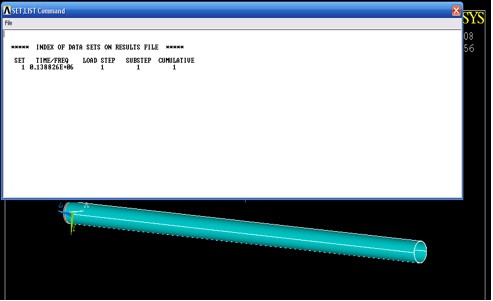
|
| An FEA analysis of the maximum (threshold) force needed to cause a carbon rod to buckle. |
3-D Analysis
Summary
References
- [Mestayer07] "Tracking Detectors for CLAS12", 1/9/07, Mac Mestayer, Collaboration Document.
- [Mestayer00] M.D. Mestayer, et. al., NIM, A449, pg 81, 2000 Media:NIM_A449.pdf
- [Craig96] Mechanics of Materials, Roy R. Craig Jr., John Wiley & Sons, 1996
